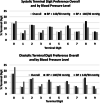Blood pressure measurement and blood pressure control in Veterans Affairs medical centers
- PMID: 37345357
- PMCID: PMC10339365
- DOI: 10.1111/jch.14684
Blood pressure measurement and blood pressure control in Veterans Affairs medical centers
Abstract
The Veterans Affairs (VA) medical centers provide care for millions of Veterans at high risk of cardiovascular disease and accurate BP measurement in this population is vital for optimal BP control. Few studies have examined terminal digit preference (TDP), a marker of BP measurement bias, clinician perceptions of BP measurement, and BP control in VA medical centers. This mixed methods study examined BP measurements from Veterans aged 18 to 85 years with hypertension and a primary care visit within 8 VA medical centers. TDP for all clinic BP measurements was examined using a goodness of fit test assuming 10% frequency for each digit. Interviews were also conducted with clinicians from 3 VA medical centers to assess perceptions of BP measurement. The mean age of the 98,433 Veterans (93% male) was 68.5 years (SD 12.7). BP was controlled (<140/90 mmHg) in 76.5% and control rates ranged from 72.2% to 81.0% across the 8 VA medical centers. Frequency of terminal digits 0 through 9 differed significantly from 10% for both SBP and DBP within each center (P < .001) but level of TDP differed by center. The highest BP control rates were noted in centers with highest TDP for digits 0 and 8 for both SBP and DBP. Clinicians reported use of semi-automated oscillometric devices for clinic BP measurement, but elevated BP readings were often confirmed by auscultatory methods. Significant TDP exists for BP measurement in VA medical centers, which reflects continued use of auscultatory methods.
Keywords: antihypertensive therapy; clinical management of high blood pressure (HBP); epidemiology; hypertension in the elderly; hypertension-general.
© 2023 The Authors. The Journal of Clinical Hypertension published by Wiley Periodicals LLC.
Conflict of interest statement
Dr. Kramer reports receiving consulting fees from Bayer Pharmaceuticals. No other author reports any competing interests.
Figures




References
-
- Whelton PK, Carey RM, Aronow WS, et al. 2017 ACC/AHA/AAPA/ABC/ACPM/AGS/APhA/ASH/ASPC/NMA/PCNA guideline for the prevention, detection, evaluation, and management of high blood pressure in adults: executive summary: a report of the American college of cardiology/American heart association task force on clinical practice guidelines. Circulation. 2018;138(17):e426‐e483. - PubMed
-
- Heidenreich PA, Bozkurt B, Aguilar D, et al. 2022 AHA/ACC/HFSA guideline for the management of heart failure: executive summary: a report of the American college of cardiology/American heart association joint committee on clinical practice guidelines. Circulation. 2022;145(18):e876‐e894. - PubMed
-
- Tsao CW, Aday AW, Almarzooq ZI, et al. Heart disease and stroke statistics‐2022 update: a report from the American heart association. Circulation. 2022;145(8):e153‐e639. - PubMed
-
- Chronic Kidney Disease Surveillance System. 2022; U.S. Department of Health and Human Services. Center for Disease Control and Prevention. Accessed February 23, 2023. https://nccd.cdc.gov/CKD/detail.aspx?Qnum=Q646#refreshPosition
-
- Military Officers Association of America. America's Health Ranking, United Health Foundation. Health of those who have served. 2022 Executive Report. Accessed February 1, 2023. https://assets.americashealthrankings.org/app/uploads/2022‐health‐of‐tho...
Publication types
MeSH terms
Substances
LinkOut - more resources
Full Text Sources
Medical
Miscellaneous

